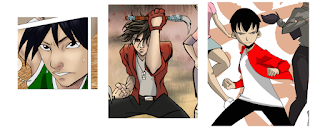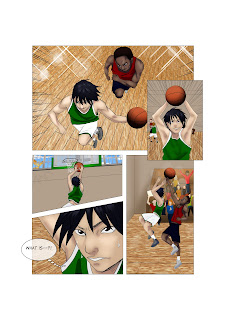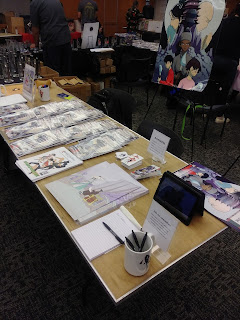Every day for me is a learning experience. I try to make sure that at the end of each day, I knew more than I did at the beginning. It helps not to rest on your own laurels. I recently did a successful Kickstarter campaign and let me tell you, I felt like a million bucks! But, even while I was fulfilling backer rewards, my mind was working on how I could improve for my next campaign, and what I could do to streamline the whole process. If you're considering doing your own Kickstarter for your comic or graphic novel, these tips will help!
#1 - Create a quality product
I know, this tip seems obvious, but there's more to it than you may think. Today's entertainment market is so advanced, so flush with different products across different mediums, that all creators are competing with each other to fill the consumer's leisure time. After a long day at work or school, people can sit down and select from 100s of movies, televisions shows, and dramas, listen to bands across dozens of genres, or download and play video games to their console.
The core of the craft is entertainment. We make comics to tackle with issues, to discuss themes and topics that are dear to us, but at the end of the day, it is entertainment. People will pick up issues of your comic ultimately to be entertained. If your comic isn't top notch, why should the consumer feel compelled to take their precious leisure time and spend it with you?
This might seem harsh, after all, creating a comic book is a lot of people's dream. My point is that we tend to see our own work in a positive light because we are so intimate with it. We WANT our readers to share in the joy of our work, but that mindset may blind us to our own failings. Is each page in your comic the best it can be? Are the color choices correct? Can you explain your themes, sub-themes, characterization, and overall message of your work?
If you objectify your work you may find that your comic might not be good enough for prime time. Few things are right off the bat! Don't let this be a blow to your ego or cause frustration. Identify an area for improvement and hammer away. Personally, my writing always suffered from flat characters. People who've read my short stories tell me the concepts are great but the characters feel lifeless. I still struggle with that, but it's a weakness I know and can try to improve.
#2 - Your work isn't for everyone, stop pretending it is.
Your work is not for everyone. Everyone will not be interested in it, and that's okay. There are few products in the market today that every human being on the planet buys. Some people like horror, some people like Norwegian Death Metal, and there are even humans who don't enjoy bacon. Your comic is no exception.
This is hard because we like our comic so much we think it has universal appeal. We figure we're right up there with the greats such as Superman or Batman. But even the big name superhero comics are not beloved by literally everyone.
Remember, comics are for entertainment. Let's take it to the next step. WHY does the reader find it entertaining? Are they imaginative and like to live in fantasy worlds? Are they comforted by the idea of good triumphing over evil? Do they enjoy explorations of human relationships? When you sit down to consume media, you do it to get something out of it emotionally or intellectually. For me, one of my favorite movies is Contact. What do I get out of watching it? I am absolutely fascinated by the concept that there are other sentient beings out there. I want to live in the future where we have amazing technology. Contact fulfills that need. I can't fulfill that need with, say, the Twilight series,which is why I've never seen it and have zero desire to.
What need does your comic fulfill? That gives you clues as to who would read it. That tells you who would actually fork over hard earned cash.
#3 - You need people who will toot your horn for you.
I'm not a soccer fan. I do enjoy playing the sport but I don't know too much about professional teams. I do know Manchester United. Why do I know the name of this team? The fans. If you think about brand awareness, why you know the brands that you know, it's partially because of people you know who advocate for that brand.
Humans are always going to take the word of someone they trust over someone they do not. Tell me something: are you more likely to sit down and watch a movie your friend recommended, or one that you just saw an advertisement for?
Social media gives us unprecedented opportunity to directly interact with fans. You need to make real human connections with people who love your work, because they will be the ones to tell their friends and family. They will be the ones that will go out on a limb and connect you with new people.
#4 - You will spend more time planning your campaign than you will executing it.
This is counter intuitive for most. Fair. You spent your time creating eye catching artwork, constructed a good story, compelling characters, and have honed whatever artistic message you want to give to your audience.
You have to spend X amount of hours just getting the word out. This means writing press releases, developing social media images, finding podcasters to interview with, reaching out to local comic book stores, getting your stories reviewed, keeping up your Twitter feed.
There's so much to do that has nothing to do with the physical implementation of your comic book. In many ways, it's just the first step. Be sure to get into that mindset. I've found that "If you build it they will come" is not always the best mantra.
#5 Better Together
Once you are on the road to publish a comic or create a Kickstarter you've entered into a community of artists, writers, letterers, and all manner of people you hadn't thought of. No one is an island. I've learned this very acutely as I am the writer for Journey to the Middle Kingdom, and I very much depend on the talents of Dimas and Novella for the artwork and all the lettering.
The comics community is highly welcoming and everyone wants to promote their stuff and are perfectly willing to promote your project as well. It's important to reach out, make friends, and don't be afraid to look for opportunities to work with other people. Think of it this way: if you are someone who has a website dedicated to comic news, you WANT to talk to new creators, artists, etc. You WANT to be on the cutting edge and talk about the next explosive comic that will get you hundreds of thousands of clicks.
It's a slog, but I view it like an adventure where I meet new party members week by week. I grow. I become more social. I realize that I have limitations and without other people I can't get to where I want to go.
I hope these 5 tips help you on your Kickstarter quest! Feel free to email me at jtmkcomic@gmail.com with any questions or comments!




















